oral english Expressions for giving advice(第二册第一单元口语表达)
- 格式:doc
- 大小:28.00 KB
- 文档页数:1
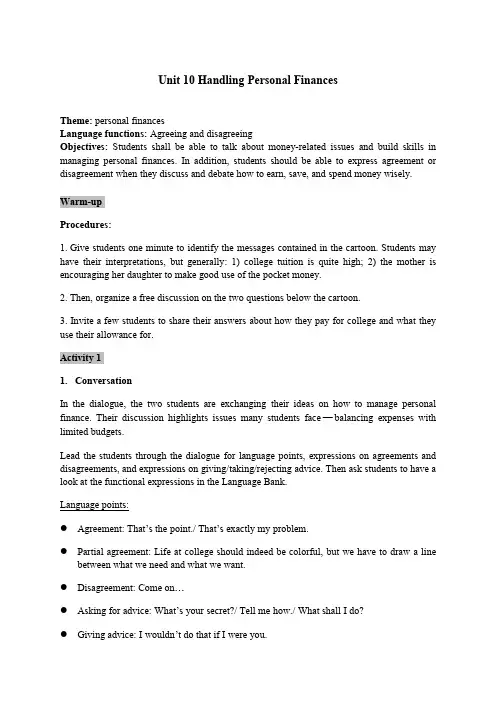
Unit10Handling Personal FinancesTheme:personal financesLanguage functions:Agreeing and disagreeingObjectives:Students shall be able to talk about money-related issues and build skills in managing personal finances.In addition,students should be able to express agreement or disagreement when they discuss and debate how to earn,save,and spend money wisely.Warm-upProcedures:1.Give students one minute to identify the messages contained in the cartoon.Students may have their interpretations,but generally:1)college tuition is quite high;2)the mother is encouraging her daughter to make good use of the pocket money.2.Then,organize a free discussion on the two questions below the cartoon.3.Invite a few students to share their answers about how they pay for college and what they use their allowance for.Activity11.ConversationIn the dialogue,the two students are exchanging their ideas on how to manage personal finance.Their discussion highlights issues many students face—balancing expenses with limited budgets.Lead the students through the dialogue for language points,expressions on agreements and disagreements,and expressions on giving/taking/rejecting advice.Then ask students to have a look at the functional expressions in the Language Bank.Language points:●Agreement:That’s the point./That’s exactly my problem.●Partial agreement:Life at college should indeed be colorful,but we have to draw a linebetween what we need and what we want.●Disagreement:Come on…●Asking for advice:What’s your secret?/Tell me how./What shall I do?●Giving advice:I wouldn’t do that if I were you.●Rejecting advice:That never works for me!2.Discussion●Focus:This task is designed to have students reflect on their financial situations andspending habits.Through the discussion,students can gain greater self-awareness of sensible consumption and learn practical strategies from their peers.●Procedures:1.Divide students into small groups of four.Ask them to take turns to share in groups if they can live within their monthly budget and what actions they take when short on money.2.Then discuss in groups what they believe are healthy financial habits for students.Each member should contribute1-2ideas.3.Bring the class back together.Invite a few representatives to summarize their discussions.4.On the board,make a list of healthy financial habits for students based on their discussion. End up by encouraging students to cultivate healthy financial habits.Additional Resources for Teachers:Here are some suggested healthy financial habits for college students:-Make a budget and track spending:Know where your money is going each month and plan based on income and expenses.-Prioritize needs over wants:Spend money on necessities like food,housing,transportation first before entertainment,shopping,etc.-Save a portion of income:Put aside a percentage of any money you receive into savings. Having an emergency fund is important.-Limit eating out:Eating at the university cafeteria is much cheaper than dining out frequently.-Find free or low-cost entertainment:Take advantage of free events,student discounts,and splitting costs with friends.-Look for freebies and deals:Get free samples,use coupons and loyalty programs.-Establish a fun money allowance:Budget a set amount each week for non-essential spending.-Pay with cash:Studies show people spend less with cash.-Avoid impulse purchases:Give yourself time to think through a purchase.-Earn extra income:Get a part-time job or freelance work to supplement your budget.-Live within your means:Don’t try to keep up with others’spending.Focus on needs.3.Pair work●Focus:This task is designed to have students analyze proverbs related to personalfinances in pairs.This exchange allows students to articulate their financial philosophies while being open-minded to other stances.●Procedures:1.Ask students to review the list of money-related proverbs and select the one they most strongly connect with or find insightful.Students can also discuss one that is not on the provided list.2.Divide students into pairs.Explain to students that they will take turns to share their selected proverb and interpretation with their partner.They may agree or disagree with each other,but they should try to use the expressions that have been introduced.3.Then the teacher may ask some volunteers to share their understanding of a particular proverb with the whole class and see if others would agree or disagree with them.●Suggested Answers:Here are some suggested answers:No one is poor unless he thinks himself so.The proverb tries to persuade people never to be beaten by troubles or difficulties in life or lose hope and confidence in winning their fortune.As long as we believe in ourselves and work hard,we can one day realize our dreams and achieve what we want.Be penny-wise and pound-foolish.Don’t focus so much on saving pennies and nickels that you miss out on bigger opportunities. Being overly frugal about small expenses is counterproductive if you waste money in more significant ways.A fool can earn money,but it takes a wise man to save and dispose of it to his advantage. Financial wisdom involves more than just earning money.Knowing how to budget,save,and use money wisely is more beneficial in the long term.Invest for the future.Neither a borrower nor a lender be.Avoid both relying heavily on borrowed money and lending money to others.Too much debt burdens the borrower.Lending money can also strain relationships sometimes.4.Group work●Focus:This task provides an opportunity for students to research the financial situationsof their peers.●Procedures:1.Divide students into groups of four.Explain to students that each group will survey student expenditures.2.Ask students to review the survey template provided.They can add or modify questions as desired.3.Give students sufficient time to conduct the survey and gather results.Suggest a minimum sample size.4.In groups,students calculate and analyze the survey results.5.Each group should prepare a summary of key findings from their survey and the implications for money management.6.Each group will present their survey methodology,results,analysis,and recommendations to the class.7.After presentations,lead a class discussion reflecting on spending habits and budgeting needs revealed from survey outcomes.8.Optional:Have students write an individual reflection on how they might adjust their own finances and spending based on the survey findings.Activity21.ConversationThis dialogue depicts a married couple,Nick and Janet,arguing over their household finances and inability to budget effectively.They are frustrated by their lack of savings and mounting expenses.The conversation reveals issues stemming from their different spending habits, incomes,and attitudes about money management.This dialogue presents an opportunity for students to analyze techniques for successful financial collaboration in relationships.2.Pair work●Focus:This creative task requires students to analyze the core issues in the couple’sdispute over finances and find reasonable compromises that address each one’s concerns.Through this task,students will demonstrate empathy,communication skills,and problem-solving skills as they work to resolve the conflicting approaches to household budgeting.●Procedures:1.Have students work in pairs.Explain to students that they will play the role of Nick and Janet and resolve the couple’s budget dispute.Give students one minute to re-read the dialogue and analyze the issues presented.2.Have students act out their extended conversation.Remind them to reach a reasonable compromise.The dialogue should end with the couple agreeing on a household budget and financial plan. This may involve:-Deciding on overall savings goals-Creating spending categories with assigned amounts-Agreeing on a system for tracking expenses-Compromising on discretionary spending items3.Invite a few volunteers to perform their completed dialogues for the class.4.Lead a short discussion reflecting on the budget solutions presented.Which compromises were most reasonable?What communication tactics worked best?5.Optional:Have students write a short reflection on what they learned about managing finances as a couple.Sample DialogueNick:I still think we need to control our spending.What if we each have an allowance to spend entirely at our discretion?Janet:But we need transparency,not separation.I don’t want to ask you for money when I need it.Nick:You’re right,that doesn’t work.Hmm,what if we have a shared account for bills and household expenses that we both contribute to based on our incomes?Then the rest ispersonal spending money.Janet:That’s better,but it doesn’t address our different attitudes about what’s worth spending on.For example,you think my books are useless.Nick:Okay,true.I suppose I should be less critical about your minor purchases if you could attempt to somewhat reduce your larger expenses.Janet:Fair enough.And we should agree on our savings goals for the year.Let’s aim to save$5000for vacations and$3000for the kids’college.Nick:Alright,it’s a deal.Should we use an app to track where all the money is going each month?That way we can catch any leaks early.Janet:Definitely.Having it all visible will help us make better choices together rather than pointing fingers.As long as we’re open to each other and work as a team,I think we can do this!Nick:Me too.I’m sorry.This is new to us but I’m glad we talked it out.Janet:Apology accepted.Now,ready to go over these credit card statements?Full transparency!Nick:You got it!Let’s do this.3.Role-play●Focus:This role-play task is designed to have students practice managing householdfinances through an improvised dialogue.The goal is to collaboratively track expenses and deposits to gain skills in household money management.●Procedures:1.Have students work in pairs.In each pair,one student should be the“big spender”and the other be the“miser.”2.Explain to students that they will play the role of a married couple who will review the monthly account book together.Remind them to take on the opposing attitudes of their roles.3.Give students a few minutes to review the account book and prepare for the role-play.The big spender should be ready to justify lavish purchases.The miser should express concern over unnecessary spending.4.Invite a few pairs to present their role-plays for the class.Pairs should aim to reconcile their different spending habits and agree on a reasonable budget and financial plan.5.Lead a discussion on the challenges of synchronizing financial viewpoints with a partner and effective strategies to enhance communication.Sample DialogueMiser:Okay,let’s go over these expenses line by line.RMB557at the shopping center?! That seems extremely high.What did you buy?Big Spender:I got some new clothes for work and a nice pair of shoes.Can’t I treat myself every once in a while?Miser:I suppose,but we need to stick to our budget.RMB80for a football ticket also seems excessive when we could watch it at home.Big Spender:It was a special event!I got to see it live with my friends.Miser:Let’s try to limit recreational spending to RMB100a month going forward.Now,the RMB200at the beauty parlor?!What’s that about?Big Spender:A girl’s got to look good!It was for a haircut and highlights.I can’t help it if the salon is pricey.Miser:Maybe try a less expensive place next time.I think we can cut this category in half. As for the RMB120movie—watching at home is way cheaper.Big Spender:Okay,I see your point.I can cut back on some of these extra treats.But could I still get some personal fun money that I don’t need to justify?Miser:That’s fair.How about we each get RMB200in discretionary spending?And we’ll save more by cooking at home and looking for free entertainment.Big Spender:It’s a deal!I want us to reach our savings goals.And I appreciate that you keep us on track.Miser:Thanks for being open to compromise.Together we’ve got this budget thing down! Activity31.How much money does a student need per month?This text discusses appropriate monthly allowances for college students in China.It centers on a university student dissatisfied with her RMB2,000monthly stipend from her parents, which she argues prevents her from indulging in luxuries like her peers.The author counters that this amount should sufficiently cover a student’s needs,citing a survey showing average undergraduate expenses in major cities were under RMB2,000.Experts advise students to adjust consumption based on family income and remember that education is the priority over material comforts.The issue reflects a generation gap in attitudes toward money, consumption values,and life priorities between Chinese youth and their elders.It also highlights the challenges of managing personal finances independently for the first time as a young adult.The text provides broader commentary on the importance of developing healthy spending habits.2.Discussion●Focus:Through this task,students will analyze their financial attitudes and deepen theirunderstanding of responsible money management and consumption habits.●Procedures:Divide students into groups of four and ask them to share their answers to the questions with group members.Remind students that they should have one member take notes of the major points that group members have made.After the group discussion,the note-takers would report their group discussion to the class.3.Role-play●Focus:This role-play scenario aims to provide an interactive way for students tointernalize the text’s themes revolving around fiscal responsibility and independence.Students could also practice agreeing and disagreeing,as well as offering and accepting suggestions through talking about money issues.Procedures:1.Divide students into pairs.In each pair,one student should be Student A and the other be Student B.2.Give students two minutes to read their role cards and get into character.Students should think about how they would act in their assigned role and improvise conversation based on their role descriptions.3.After five minutes of role-playing,the teacher will invite some students to present their role-play to the class.5.To conclude,students share their experiences and discuss what they learned about from this activity,and the teacher will summarize the insights gained.Sample Dialogue:Student A:I can’t believe my parents haven’t bought me a laptop yet.How do they expect me to do my schoolwork without one?It’s ridiculous that they haven’t provided me with this basic necessity for studying.Student B:I’m sorry to hear you don’t have a laptop,but maybe your parents can’t afford one right now.My parents give me a monthly allowance that’s usually enough,but lately, I’ve been donating some of it to charity so I’m short on cash.Student A:Well,if I were you,I’d tell my parents to give me more money.They should be responsible for making sure you have everything you need as a student.Student B:I disagree.I think we need to learn to be independent and make sacrifices sometimes.Your parents probably want you to focus on your studies rather than expensive gadgets.Student A:I guess you have a point.I don’t need the latest laptop.I should be grateful that my parents provide for my basic needs.It’s admirable that you’re donating your own money to help others in need.Student B:Thank you.But now I’m worried about covering my expenses.Do you have any ideas on how I could earn some extra money?Student A:Hmm...you could tutor younger students or get a part-time job on campus.Let me know if you need help!Student B:Those are great suggestions!Thanks for your advice!Supplementary Activity1.Learn to spend sustainablyThe passage offers advice for developing healthy spending habits and avoiding financial issues stemming from overspending.It targets readers who struggle with impulse purchases or have trouble differentiating between wants and needs.2.Discussion●Focus:This discussion aims to have students reflect on their spending habits andevaluate the effectiveness of the tips for avoiding impulsive purchases.●Procedures:1.Explain to students that the goal of this discussion is to reflect on their spending habits and evaluate strategies for controlling impulsive purchases.Encourage students to be open about sharing their experiences.2.Invite a few volunteers to describe a time they made an impulsive e probing questions to understand their motivations.3.After a few students have shared,facilitate a whole-class discussion on the effectiveness of the tips provided in the passage.Ask students to explain their perspectives.4.Invite students who have tried any of the techniques to describe their experiences implementing them.Did the strategies help manage spending?Have each student identify one tip they would be willing to try and explain why they think it would work for them.5.Leave five minutes at the end for students to reflect individually on new insights they have gained about sustainable spending habits.Definition:Impulsive buying,or impulsive spending,is the tendency of a customer to buy goods and services without planning.When a customer makes such buying decisions at the spur of the moment,it is usually triggered by emotions and feelings.Description:Impulsive buying can’t be categorized for one specific product category. Impulsive buying can be seen in products such as chocolates,clothes,and mobile phones and in big-ticket items such as cars,jewelry,etc.Impulsive buying means making an unplanned purchase.It is based on an irrational thinking.Marketers try to tap this behavior of customers to boost sales.There is a great likelihood that customers end up making a purchase ofproducts after entering the hypermarket without any actual intent of doing so.Many mobile phone makers tend to exploit this trait in customers by introducing products that can be add-on gadgets for their mobiles such as fitness bands,etc.。
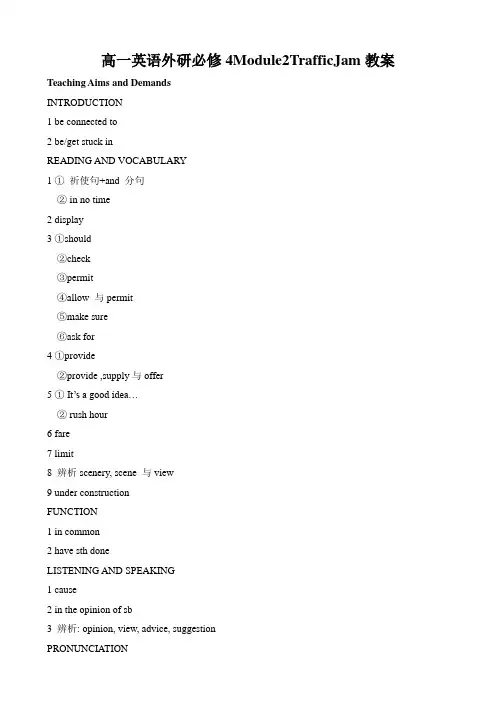
高一英语外研必修4Module2TrafficJam教案Teaching Aims and DemandsINTRODUCTION1 be connected to2 be/get stuck inREADING AND VOCABULARY1 ①祈使句+and 分句② in no time2 display3 ①should②check③permit④allow 与permit⑤make sure⑥ask for4 ①provide②provide ,supply与offer5 ①It’s a good idea…② rush hour6 fare7 limit8 辨析scenery, scene 与view9 under constructionFUNCTION1 in common2 have sth doneLISTENING AND SPEAKING1 cause2 in the opinion of sb3 辨析: opinion, view, advice, suggestionPRONUNCIATION1 辨析: seem, look 与appear2 辨析: aloud, loud 与loudly3 Why not…4 not only …but also5 had betterSPEAKING1 room2 辨析: space 与roomWRITING1 as a result2 mean to do 与mean doing3 辨析: besides, except 与except forEVERYDAY ENGLISH1 no way2 drive sb madCULTURAL CORNER1 suffer2 so… that…3 agree4 even if 与even thoughGRAMMAR祈使句1 give advice2 give instructions3 switch off4 keep coolTeaching paper for period 1: Introduction and ReadingStep1:Lead-in1>Present different kinds of pictures of means of transport and ask questions :①Which of them do you prefer to take to go around the city?②Can you name all of them in English?2> Let students pay more attention to the words: coach and trolleybus. Explain them and letthe students follow you.Step 2: Match the words with their definitionsAfter some pictures of means of transport, the students are familiar with the words. Theteacher can ask students to do the exercise individually or divide the whole class intogroups and have a competition.Step 3: Make up sentences1>Ask students to make short sentences according to the example. They should makesentences according to the fact.2>Or they may ask each other questions in pairs. For example:Which means of transportation do you prefer?Do you always take a bus to school?Step 4: Share your answers with your partner.Encourage the students to speak English as much as possible to practice their oral English.During this period some language mistakes should be allowed as long as they can expresstheir meanings.Step 5: Match the words with their meanings.This part is provided as a warming-up for the upcoming reading. Because by doing thisthey can get more familiar with some of the new words. Teachers can call back the answer as a whole class.Step 6: ListeningListen to the tape for the text and find what means of transportation are mentioned in thepassage. This step can save some time and test the students’ list ening skills as well .Step 7: Fast-readingRead the text fast and try to get the main idea of the passage. Then fill in the chart. Allow them to discuss the questions if they find it difficult.Step 8: Detail-readingRead the text carefully again and answer the questions.Teachers may allow students to finish this part in pairs.Make sure they answer the questions in complete sentences.Step 9: Fill in the blanksAfter three times of going through the passage, students may be very similar with theontents. So this time, let them close the books and fill in the blanks.This step may be offered as a small competition to see who can fill in the form correctly. Step 10: HomeworkWrite the passage in step 9 on your exercise book and hand it in.Teaching paper for period 2: Listening, Everyday English and SpeakingStep 1: Lead-inWe’ll think of some places of interest whenever Beijing is mentioned: the Summer Palace, the Forbidden City , the Great Wall and so on. (present some pictures of these places of interest at the same time) But have you thought of the traffic in Beijing. What do people in Beijing think of the traffic in Beijing? In order to solve this question, let’s come to listening.Step2: Listen for the first timeListen to people of Beijing speaking about traffic problems in the city.Before you listen, tick the topics you think they will talk about. Thenlisten to the tape to check the answers.Step3: Listen for the second time1>Listen again and match the traffic situations with the speakers.2>Choose the correct sentences.Step4: Listen for the third timeListen to the tape for the third time and answer the questions in pairs.Step5: Everyday EnglishThe sentences are all taken from the listening passage. So it would be better to finish thisart just after listening. If the students in your class are advanced ones, you can let them tomake up a short dialogue using some of the expressions.Step6: SpeakingThis part is also related to the listening passage.There are some expressions for giving advice:1>Wh y not …2>Th ey/ We should /shouldn’t …3>Th ey/We could /should…3>Why don’t you…?Encourage students to use these expressions to form several sentences to advise how to improve the traffic situation in the city of Beijing.Step 7: HomeworkWrite the sentences on your exercise book.Teaching paper for period 3: Cultural Corner, Grammar and Writing]Step1: Lead-in for Cultural CornerLead into the passage by asking two questions:1>What problem will come about if a city has too much traffic?2>Suppose you are a mayor of London, what measure will you take to solve the trafficproblems caused by too much traffic?Encourage them to open their mouth and speak English as much as they can , and thus students and teachers can enjoy a lively atmosphere.Step2: read and answerRead the passage quickly and answer the questions:1 What is a congestion charge?2 Why are there traffic jams in London?Step3: read again and answer more questionsWork in groups and answer the following questions.1 What are people’s attitudes towards this policy?2 Would a congestion charge be a good idea in your town?Step4: Language pointsExplain some language points in the passage and for some of them some students can be asked to answer some of your questions.Step5: Grammar1>Present some pictures to lead into IMPERATIVES we’re going to learn.2>Explain some detail knowledge.3>Do some exercise to consolidate what has been learned.Step6: WritingRead the passage on P18 and answer the following 5 questions:1 How many problems does the writer talk about?2 What are the causes of the problems?3 How many solutions does the writer find?4 Who are they in They should close the city center?5 Why does the writer divide the passage into two parts? Step7: HomeworkWrite a similar passage about your town.。
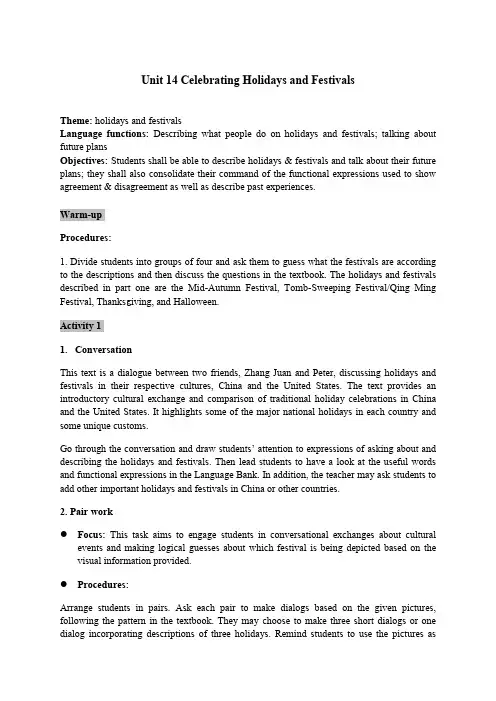
Unit14Celebrating Holidays and FestivalsTheme:holidays and festivalsLanguage functions:Describing what people do on holidays and festivals;talking about future plansObjectives:Students shall be able to describe holidays&festivals and talk about their future plans;they shall also consolidate their command of the functional expressions used to show agreement&disagreement as well as describe past experiences.Warm-upProcedures:1.Divide students into groups of four and ask them to guess what the festivals are according to the descriptions and then discuss the questions in the textbook.The holidays and festivals described in part one are the Mid-Autumn Festival,Tomb-Sweeping Festival/Qing Ming Festival,Thanks g iving,and Halloween.Activity11.ConversationThis text is a dialogue between two friends,Zhang Juan and Peter,discussing holidays and festivals in their respective cultures,China and the United States.The text provides an introductory cultural exchange and comparison of traditional holiday celebrations in China and the United States.It highlights some of the major national holidays in each country and some unique customs.Go through the conversation and draw students’attention to expressions of asking about and describing the holidays and festivals.Then lead students to have a look at the useful words and functional expressions in the Language Bank.In addition,the teacher may ask students to add other important holidays and festivals in China or other countries.2.Pair work●Focus:This task aims to engage students in conversational exchanges about culturalevents and making logical guesses about which festival is being depicted based on the visual information provided.●Procedures:Arrange students in pairs.Ask each pair to make dialogs based on the given pictures, following the pattern in the textbook.They may choose to make three short dialogs or one dialog incorporating descriptions of three holidays.Remind students to use the pictures asprompts to practice talking about different holidays and festivals.The goal is to identify the celebration based on the visual clues.Then the teacher may ask two or three pairs to role-play their conversation(s).Provide feedback on the content and language used.Highlight any new vocabulary or proper holiday names introduced through the activity.3.Mini-speech●Focus:The goal of this task is for students to strengthen their public speaking andpresentation skills by individually preparing and delivering a short speech about a holiday or festival to their peer group.Students will select a celebration from the provided list,research key details about its history,customs,and origins,and create a two-minute informative presentation to group members.●Procedures:1.Divide students into groups.Have each student select one holiday/festival from the provided list.2.Give students a few minutes to prepare a short two-minute presentation about their chosen holiday/festival.They should include key details like the date,traditions,origins,etc.3.Have each student take turns giving their mini-presentation to the group.Encourage them to speak loudly and clearly.4.After each presentation,the other group members could ask follow-up questions about the holiday.This allows the presenter to provide more detail.5.When all students have presented,lead a brief class discussion reflecting on what they learned about different cultural celebrations from their peers.6.Provide positive feedback on the content and public speaking skills demonstrated. Sample Speech and Q&AThe festival I will talk about today is the Lantern Festival.This festival takes place on the15th day of the first month of the lunar calendar.It marks the end of the Chinese New Year celebrations.The Lantern Festival has a history of over2,000years.During this festival,people light lanterns and hang them around temples,in the streets,parks,and even near rivers and lakes.The lanterns come in all shapes,sizes and colors,often with Chinese symbols, animals from the zodiac,or scenes from myths.The lanterns symbolize hope for the new year.Families carry lanterns to join in parades and events.There are often fireworks, dances,and lion dances too.Eating round sticky rice balls called yuanxiao in Chinese is a popular custom,because their round shape matches the full moon on this night.The Lantern Festival is about bringing families together to celebrate while welcoming the first full moon.Q&A:Q:When was the first Lantern Festival held?A:The Lantern Festival began during the Han Dynasty,over2,000years ago.Q:What foods do people eat during this festival?A:Common foods eaten during this festival are sticky rice balls called yuanxiao and round-shaped dumplings.These match the full moon.Q:What makes the lanterns special?A:The lanterns come in all sizes,shapes and colors.Many have Chinese symbols,animals or myths depicted on them.They symbolize hope.Activity21.ConversationsThe two conversations in this activity focus on talking about future plans and usual practice on certain holidays.Lead students through the two conversations and ask them if they know anything about the origin of the April Fool’s Day and the Dragon Boat Festival.Students may also share some interesting April Fool’s stories and some different ways of celebrating the Dragon Boat Festival in different parts of China.2.Pair work●Focus:This task focuses on using the phrase“I am going to”to discuss future holidayplans.This allows students to practice talking about the future in English while learning about their partner’s holiday traditions and plans.●Procedures:1.Divide students in pairs.Ask each pair to follow the instructions in the textbook and remind them to think about what they learned in Unit3to talk about future plans and try to use the expressions they learned.2.Students will take turns using the phrase“I am going to”to discuss their plans.They could discuss activities,food,places they will visit,people they will see,etc.Students should aim to provide3-5“I am going to...”statements for each holiday prompt.3.After both students have had a chance to share their plans,the teacher can invite some pairs to share with the class.3.Story-telling●Focus:This task aims to get students to share some interesting/memorable personalexperiences or stories related to a holiday tradition holidays by using3-5key details.By recounting events in sequence using the past tense,students can improve their ability to narrate a coherent story in English.●Procedures:Divide students into groups.Students will take turns sharing stories about memorable experiences they’ve had on Chinese or Western holidays/festivals.Remind students that they need to give as many details as possible to make their stories vivid and impressive.Stories should focus on a specific holiday event or tradition and past tenses should be used to describe what happened.If a student does not have a relevant personal experience to share, they can share an interesting,moving,or funny holiday story they have heard before.After the group work,the teacher may ask some volunteers to share their stories in front of the class.Activity31.FestivalsThis text explores two major cultural festival traditions—China’s Spring Festival(Lunar New Year)and the American holiday of Thanksgiving.It first provides background on Spring Festival,describing the celebrations,customs,and activities associated with this revered start of the lunar new year.Details are given about the significance of family gatherings,traditions like hanging red banners and staying up late on New Year’s Eve,visiting relatives,and enjoying public festivities.The text then shifts to discuss the origins and modern practices of Thanksgiving in America. It recounts how the Pilgrims started the tradition in1621after surviving a difficult winter thanks to the help of Native Americans.Their inaugural feast and celebration of a bountiful harvest spawned an ongoing national holiday.Thanksgiving is associated with family gatherings,travel,special meals featuring turkey and pumpkin pie,and giving thanks for one’s blessings.Together,the passages showcase two major cultural holiday traditions and how they bring families and communities together through celebration,shared history,and gratitude.Lead students through the text and ask them to summarize what kind of information should be included in an introduction of a holiday or ually,when,how and with whom the holiday or festival is celebrated are necessary,and then the origin,related stories, importance as well as cultural implications may also be included.2.Pair work●Focus:This task allows students to compare and contrast customs and traditions betweenmajor Chinese and Western holidays.Students will work in pairs to identify similarities and differences across six festival pairings.This promotes cultural understanding of how celebrations vary across regions.●Procedures:The teacher may introduce some patterns often used to talk about similarities and differences before dividing the students into groups.Each group may first brainstorm on the customs of all the Western and Chinese festivals in the table and have a discussion of the similarities and differences between each pair.After discussion and completing the table,students will share what they listed with the class and explain the cultural significance.Suggested Answers:Festivals Similarities DifferencesChristmas vs.Spring Festival -Family gatherings-Decorating homes-Exchanging gifts-Christmas:Christianity;turkeySpring Festival:Lunarcalendar;jiaozi;fireworksValentine’s Day vs.Qixi Festival -love/romance-Gifts to loved ones-Festival tales about couples-Qixi:traditional Chinesestory;activities likewatching stars-Valentine’s:more widelycelebratedHalloween vs.Qingming Festival -Respect to the deceased-Rituals and offerings-Halloween:morelighthearted;costumes andcandy-Qingming:more reverentand solemnThanksgiving vs.Mid-Autumn Festival -Family gatherings-Feasts/meals-Harvest origins-Thanksgiving:Americanhistory-Mid-Autumn:mooncakes,lanterns and moon viewing3.Interview●Focus:The task focuses on encouraging students to think about and voice their opinionson Chinese and Western festivals and how people should celebrate them in the present era.The discussion promotes critical thinking on cultural evolution.●Procedures:The teacher may start by asking students how they feel about traditional holidays now compared with how they felt when they were young.Then,students may give their opinions about how people may maintain or adjust the customs.4.Show and tell●Focus:The task is designed for the students to look for information about a particularfestival of an ethnic group and integrate what they have collected into a presentation.●Procedures:The teacher may assign the task in class and leave it as homework for students to look for related information and prepare for the presentation.Divide students into groups of four and ask them to first decide on a festival of an ethnic group.The teacher needs to make sure that each group focuses on a different festival from other groups.Then,ask students to think about what they would like to include in their presentation and how they can make their presentation more impressive.In addition,remind them to have a proper allocation of work and ensure good cooperation among the group members.Finally in class,each group does their presentation and other groups give their comments on the content and performance of the presentation.Supplementary Activity1.ConversationThis is a conversation between Rick,an American exchange student studying Chinese culture at Peking University,and his Chinese friend Cherry.It takes place on the evening of the Mid-Autumn Festival,a major traditional holiday in China.Their conversation provides insight into Chinese traditions around the Mid-Autumn Festival.The teacher may make use of the activity to get students to know more about the festivals celebrated in China and appreciate the cultural diversity of our country.2.Role-play●Focus:This task is for the students to demonstrate an understanding of a key Chineseholiday,the Winter Solstice Festival.Students work in pairs and roleplay the original characters of Rick and Cherry.●Procedures:1.Have students work in pairs,with one partner playing Rick and the other playing Cherry. Explain that the scene is now the Winter Solstice Festival.2.Rick should ask questions to learn about the Winter Solstice Festival,such as its origins, traditions,foods,etc.Cherry will explain details about the festival and how Chinese people celebrate it.Encourage to use prior cultural knowledge.3.Have students perform their role-plays for the class.After each role-play,briefly discuss key information presented about the festival.Sample DialogueRick:Hi Cherry!Happy Winter Solstice Festival!Thanks for inviting me over to celebrate again.Cherry:You’re welcome,Rick!I’m excited to tell you about another Chinese holiday. Rick:Me too!So can you explain what the Winter Solstice Festival is all about?When is it celebrated?Cherry:The Winter Solstice Festival is one of the most important festivals in China.It takes place around December21st,the shortest day of the year.Rick:Interesting!What are the origins of this festival?Cherry:It originated over2,000years ago.Ancient Chinese people celebrated the solstice because it means the days would start getting longer again as spring approaches.Rick:That makes sense.I read the solstice has something to do with yin and yang. Cherry:Yes,exactly!The solstice represents yin transitioning to yang—from the darkness of winter to the light of spring.Rick:Nice.So how do Chinese people celebrate today?What are the traditions? Cherry:There are many fun customs!Eating jiaozi and spending time with family.Also ancestor worship and lighting candles.Rick:It sounds very meaningful.I’d love to experience all of that someday.Well,thanks for telling me about this great Chinese festival!Cherry:You’re welcome!I’m happy to share our culture with you.Ready for our feast?3.Pair work●Focus:This activity prompts students to discuss and compare regional variations incelebrating traditional Chinese holidays and festivals.Students will activate prior knowledge and share experiences to highlight how geography and local culture lead to diverse paring traditions boosts cultural understanding.●Procedures:Have students work in pairs.Students in each pair may start with sharing how certain traditional festivals are celebrated in their hometown and see if there are any differences.In addition,they may share whatever they know of or have heard of the different ways of celebrating traditional festivals in different places.Remind students to make use of the expressions introduced in Task1for Activity3to talk about these differences.Encourage students to explain why certain regional variations developed.Consider geography,ethnic groups,available foods,etc.Have some pairs briefly share their examples with the class.。
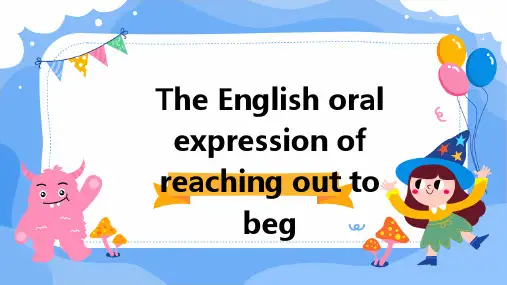
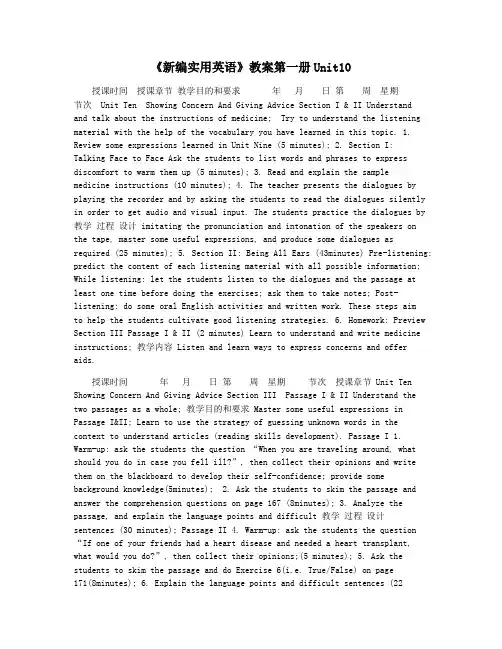
《新编实用英语》教案第一册Unit10授课时间授课章节教学目的和要求年月日第周星期节次 Unit Ten Showing Concern And Giving Advice Section I & II Understandand talk about the instructions of medicine; Try to understand the listening material with the help of the vocabulary you have learned in this topic. 1. Review some expressions learned in Unit Nine (5 minutes); 2. Section I:Talking Face to Face Ask the students to list words and phrases to express discomfort to warm them up (5 minutes); 3. Read and explain the samplemedicine instructions (10 minutes); 4. The teacher presents the dialogues by playing the recorder and by asking the students to read the dialogues silently in order to get audio and visual input. The students practice the dialogues by 教学过程设计 imitating the pronunciation and intonation of the speakers onthe tape, master some useful expressions, and produce some dialogues asrequired (25 minutes); 5. Section II: Being All Ears (43minutes) Pre-listening: predict the content of each listening material with all possible information; While listening: let the students listen to the dialogues and the passage at least one time before doing the exercises; ask them to take notes; Post-listening: do some oral English activities and written work. These steps aimto help the students cultivate good listening strategies. 6. Homework: Preview Section III Passage I & II (2 minutes) Learn to understand and write medicine instructions; 教学内容 Listen and learn ways to express concerns and offer aids.授课时间年月日第周星期节次授课章节 Unit Ten Showing Concern And Giving Advice Section III Passage I & II Understand the two passages as a whole; 教学目的和要求 Master some useful expressions in Passage Iⅈ Learn to use the strategy of guessing unknown words in thecontext to understand articles (reading skills development). Passage I 1.Warm-up: ask the students the question “When you are traveling around, what should you do in case you fell ill?”, then collect their opinions and write them on the blackboard to develop their self-confidence; provide some background knowledge(5minutes); 2. Ask the students to skim the passage and answer the comprehension questions on page 167 (8minutes); 3. Analyze the passage, and explain the language points and difficult 教学过程设计sentences (30 minutes); Passage II 4. Warm-up: ask the students the question“If one of your friends had a heart disease and needed a heart transplant, what would you do?”, then collect their opinions;(5 minutes); 5. Ask the students to skim the passage and do Exercise 6(i.e. True/False) on page171(8minutes); 6. Explain the language points and difficult sentences (22minutes); 7. Review the useful expressions learned in these two passages (10 minutes); 8. Homework: preview Section IV; finish the exercises after passage I&II (2 minutes) 教学内容 Learning Passage Iⅈ Mastering some useful expressions.授课时间年月日第周星期授课章节教学目的和要求Unit Ten Showing Concern And Giving Advice Section IV Trying Your Hand Develop translation skills; Master the methods to change simple sentences into coordinate ones. 1. Check the exercises after the two passages and make necessary explanations (28 minutes); 2. Section IV: translate the instructions for taking medicines by using 教学过程设计 translation skills (15 minutes);3. Explain grammar rules, i.e. conjunction (15 minutes);4. Finish the exercises (20 minutes);5. Review the whole unit (10 minutes);6. Homework: review this unit (2 minutes). 节次教学内容 Grammar: ways to combine sentences into coordinate ones Finish the exercises.Unit TenShowing Concern and Giving AdviceI. Objectives:By the end of this unit, the students should be able to 1) read, discuss and translate medications in English,2) learn some expressions used in showing concern and giving advice,3) comprehend the two passages and master the useful expressions in them, and 4) finish the exercises by themselves or with some help.II. IntroductionLead-in(导入): First, the students are asked to discuss thetopic―illness. Then their opinions are written down on the blackboard. Finally, the introductory remarks will be made by the teacher as follows:Everybody falls ill once in a while. When you are ill you may have to go tohospital to see the doctor. Illnesses range from skin troubles to cancers. Whatever you may be going to see the doctor for, you may often get aprescription for different medicines. In this unit we will learn how to express discomfort, show concern and give advice.III. Teaching Procedures:Section I. Talking Face to FaceStep 1. Presentation: Read the following two Samples of Medicine InstructionsHere are instructions for taking two different medications. Read and try to talk about them in English. Sample 1Throat Spray The spray is made up of vitamins and mint. It is used for the relief of a sore and dry throat. It is also helpful for persistent cough. Spray gently into open mouth, three times a day. Don't drink or eat anything immediately after use. Keep in cool dry place.Sample 2Vitamin E Skin Oil Capsule Ingredients: Vitamin E and vegetable oil. Functions: Smooth dry and rough skin. Application: Squeeze capsule and apply contents to desired area. Rub the lotion into your skin. Caution: Do not allow the lotion to come into contact with eyes. Keep out of reach of children. Store in a cool, dry place. --The Way of Showing Concern1. What’s the matter with you?2. What’s the trouble with you?3. What’s wrong with you?4. Is there anything wrong?5. Are you all right (Ok)?6. You don’t look quite yourself.7. You don’t look well.--The Way of Expressing One’s Sickness 8. I’m feeling awful.9. I’ve got a terrible headache. 10. I’ve got a sore throat. 11. I feel sick.12. My whole body hurts badly.13. I’m seriously ill and running a high fever.感谢您的阅读,祝您生活愉快。
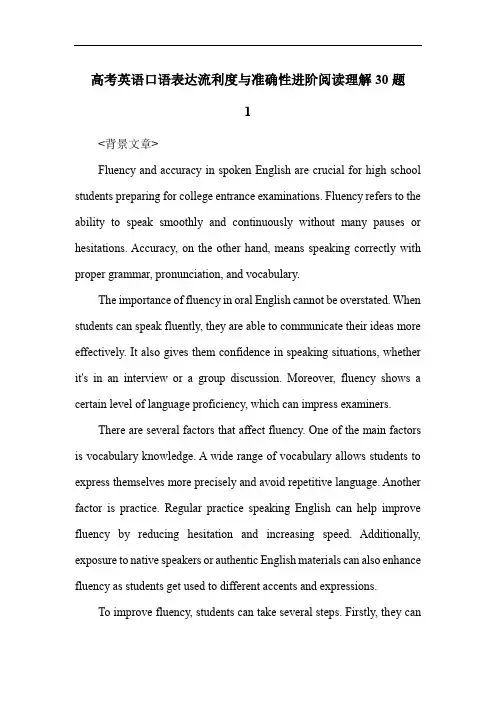
高考英语口语表达流利度与准确性进阶阅读理解30题1<背景文章>Fluency and accuracy in spoken English are crucial for high school students preparing for college entrance examinations. Fluency refers to the ability to speak smoothly and continuously without many pauses or hesitations. Accuracy, on the other hand, means speaking correctly with proper grammar, pronunciation, and vocabulary.The importance of fluency in oral English cannot be overstated. When students can speak fluently, they are able to communicate their ideas more effectively. It also gives them confidence in speaking situations, whether it's in an interview or a group discussion. Moreover, fluency shows a certain level of language proficiency, which can impress examiners.There are several factors that affect fluency. One of the main factors is vocabulary knowledge. A wide range of vocabulary allows students to express themselves more precisely and avoid repetitive language. Another factor is practice. Regular practice speaking English can help improve fluency by reducing hesitation and increasing speed. Additionally, exposure to native speakers or authentic English materials can also enhance fluency as students get used to different accents and expressions.To improve fluency, students can take several steps. Firstly, they canread aloud regularly to improve pronunciation and intonation. Reading a variety of materials such as newspapers, novels, and poems can also expand vocabulary. Secondly, they can engage in conversations with classmates or language partners. This not only provides practice but also helps students learn from others. Thirdly, watching English movies, TV shows, or listening to English podcasts can expose students to natural language use and improve their understanding of different contexts.In conclusion, fluency and accuracy in spoken English are essential for high school students aiming for success in college entrance examinations. By understanding the importance of fluency, identifying the factors that affect it, and taking appropriate measures to improve it, students can enhance their oral English skills and perform better in exams.1. Fluency in spoken English means being able to speak ________ without many pauses or hesitations.A. slowly and carefullyB. smoothly and continuouslyC. loudly and clearlyD. quickly and nervously答案:B。
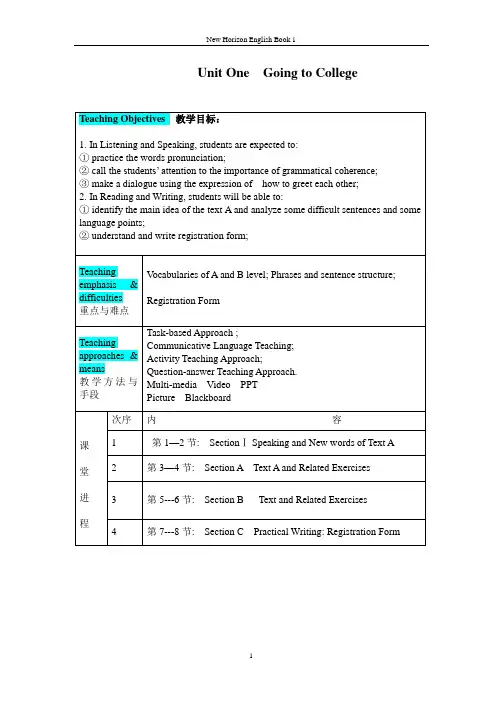
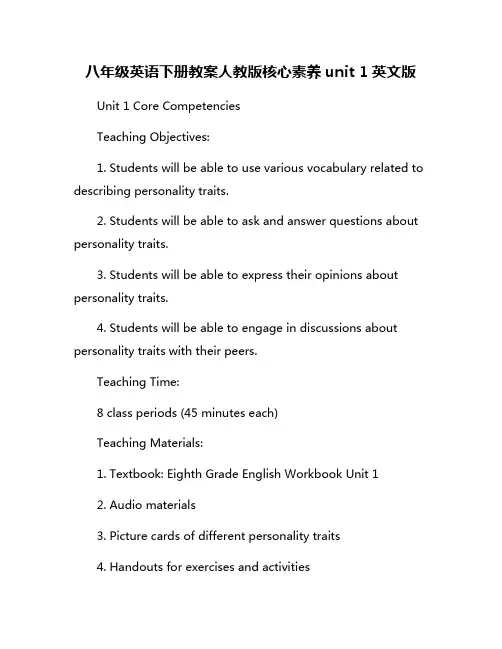
八年级英语下册教案人教版核心素养unit 1英文版Unit 1 Core CompetenciesTeaching Objectives:1. Students will be able to use various vocabulary related to describing personality traits.2. Students will be able to ask and answer questions about personality traits.3. Students will be able to express their opinions about personality traits.4. Students will be able to engage in discussions about personality traits with their peers.Teaching Time:8 class periods (45 minutes each)Teaching Materials:1. Textbook: Eighth Grade English Workbook Unit 12. Audio materials3. Picture cards of different personality traits4. Handouts for exercises and activitiesTeaching Procedures:Class 1:1. Warm-up: Play a game where students have to act out a personality trait without speaking and their classmates have to guess what it is.2. Introduce new vocabulary related to personality traits such as confident, outgoing, shy, funny, serious, etc.3. Practice pronunciation of the new vocabulary and have students repeat after you.4. Have students write short sentences using the new vocabulary.5. Homework: Review the new vocabulary at home and prepare to discuss personality traits in the next class.Class 2:1. Review the vocabulary from the previous class.2. Introduce question words such as "What's he/she like?" and "Is he/she...?"3. Engage students in pair work where they ask and answer questions about each other's personality traits.4. Discuss different personality traits in the class and have students express their opinions about them.5. Homework: Write a short paragraph describing their own personality traits.Class 3:1. Review the previous class's homework.2. Introduce adjectives to describe personality traits in more detail such as friendly, kind, energetic, etc.3. Practice using the new adjectives in sentences and short dialogues.4. Have students work in groups to create a skit where they act out different personality traits.5. Homework: Write a dialogue between two people discussing their personality traits.Class 4:1. Review the homework from the previous class.2. Listen to audio materials of different conversations about personality traits and have students answer questions based on them.3. Introduce expressions for giving opinions such as "In my opinion..." and "I think that..."4. Practice using the new expressions in discussions about personality traits.5. Homework: Prepare to present their skits in the next class.Class 5:1. Have students present their skits to the class.2. Discuss the different personality traits demonstrated in the skits and have students give feedback on each other's performances.3. Introduce vocabulary related to emotions such as happy, sad, angry, etc.4. Practice using the new vocabulary in sentences and short dialogues.5. Homework: Write a short paragraph describing how they feel about different situations.Class 6:1. Review the previous class's homework.2. Engage in a group discussion about different emotions and have students express their opinions on how to deal with them.3. Introduce expressions for expressing emotions such as "I feel..." and "It makes me feel..."4. Practice using the new expressions in discussions about emotions.5. Homework: Write a diary entry describing their emotions throughout the day.Class 7:1. Review the homework from the previous class.2. Listen to audio materials of different situations that evoke different emotions and have students answer questions based on them.3. Introduce expressions for asking for advice such as "What should I do?" and "Can you help me with...?"4. Practice using the new expressions in giving advice on how to deal with different emotions.5. Homework: Prepare to present their diary entries in the next class.Class 8:1. Have students present their diary entries to the class.2. Discuss the different emotions described in the entries and have students give feedback on each other's writing.3. Review all the vocabulary, expressions, and concepts learned in the unit.4. Engage in a group discussion about the importance of understanding and expressing personality traits and emotions.5. Homework: Write a reflection on what they have learned in this unit and how it has impacted their understanding of themselves and others.Assessment:1. Participation in class activities and discussions.2. Completion of homework assignments.3. Quiz on vocabulary, expressions, and concepts learned in the unit.4. Oral presentation of skits, dialogues, and diary entries.5. Reflection on learning outcomes.By following these teaching procedures and assessment methods, students will be able to improve their English language skills while also gaining a deeper understanding of themselves and others through discussions about personality traits and emotions. This unit will not only enhance their language proficiency but also contribute to their personal growth and interpersonal relationships.。
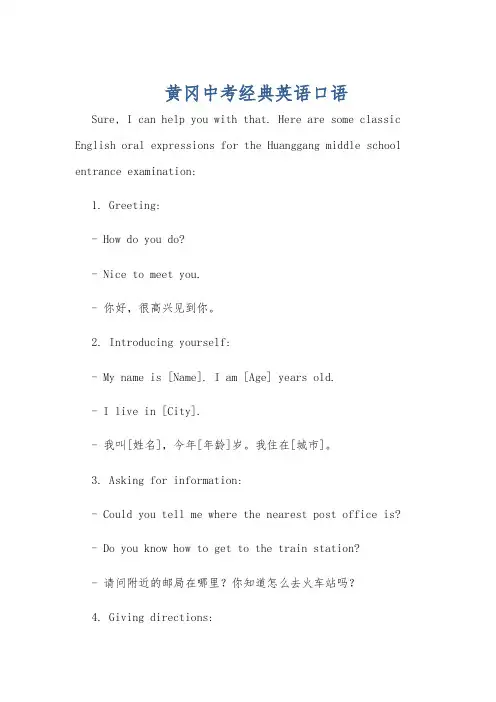
黄冈中考经典英语口语Sure, I can help you with that. Here are some classic English oral expressions for the Huanggang middle school entrance examination:1. Greeting:- How do you do?- Nice to meet you.- 你好,很高兴见到你。
2. Introducing yourself:- My name is [Name]. I am [Age] years old.- I live in [City].- 我叫[姓名],今年[年龄]岁。
我住在[城市]。
3. Asking for information:- Could you tell me where the nearest post office is?- Do you know how to get to the train station?- 请问附近的邮局在哪里?你知道怎么去火车站吗?4. Giving directions:- Go straight and turn left at the second intersection.- It's on your right, next to the bank.- 直走,在第二个路口左转。
它在你右边,靠近银行。
5. Expressing opinions:- In my opinion, studying hard is very important.- I think it's a good idea to join a club or activity.- 在我看来,努力学习非常重要。
我认为参加俱乐部或活动是个好主意。
6. Expressing preferences:- I prefer reading books to watching TV.- I like playing basketball more than soccer.- 我更喜欢看书而不是看电视。
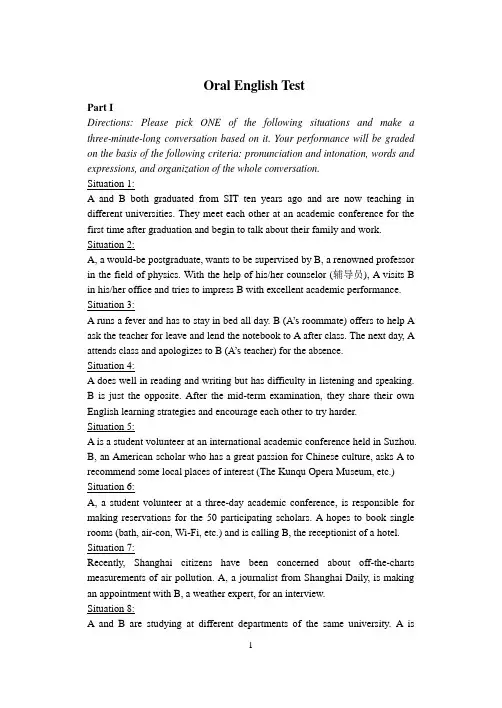
Oral English TestPart IDirections: Please pick ONE of the following situations and make a three-minute-long conversation based on it. Your performance will be graded on the basis of the following criteria: pronunciation and intonation, words and expressions, and organization of the whole conversation.Situation 1:A andB both graduated from SIT ten years ago and are now teaching in different universities. They meet each other at an academic conference for the first time after graduation and begin to talk about their family and work. Situation 2:A, a would-be postgraduate, wants to be supervised by B, a renowned professor in the field of physics. With the help of his/her counselor (辅导员), A visits B in his/her office and tries to impress B with excellent academic performance. Situation 3:A runs a fever and has to stay in bed all day.B (A’s roommate) offers to help A ask the teacher for leave and lend the notebook to A after class. The next day, A attends class and apologizes to B (A’s teacher) for the absence.Situation 4:A does well in reading and writing but has difficulty in listening and speaking.B is just the opposite. After the mid-term examination, they share their own English learning strategies and encourage each other to try harder.Situation 5:A is a student volunteer at an international academic conference held in Suzhou. B, an American scholar who has a great passion for Chinese culture, asks A to recommend some local places of interest (The Kunqu Opera Museum, etc.) Situation 6:A, a student volunteer at a three-day academic conference, is responsible for making reservations for the 50 participating scholars. A hopes to book single rooms (bath, air-con, Wi-Fi, etc.) and is calling B, the receptionist of a hotel. Situation 7:Recently, Shanghai citizens have been concerned about off-the-charts measurements of air pollution. A, a journalist from Shanghai Daily, is making an appointment with B, a weather expert, for an interview.Situation 8:A andB are studying at different departments of the same university. A islearning English for Academic Purposes (EAP) while B is learning English for General Purposes (EGP). They are talking about the differences.Part IIDirections: You are going to answer ONE question about the following topics in 1minute.Question 1: Western universities and Chinese universitiesQuestion 2: general education (通识教育)Question 3: English as a lingua franca (英语作为通用语)Question 4: English hegemony (英语霸权)Question 5: rote learning: useful or uselessQuestion 6: narration: the best way to learnQuestion 7: the characteristics of lifelong learnersQuestion 8: the importance of creation and innovationQuestion 9: Western parenting and Chinese parentingQuestion 10: parent-child relationship (亲子关系)Question 11: motherly love and fatherly love (母爱与父爱)Question 12: the purpose of educationQuestion 13: the qualities of an educated personQuestion 14: knowledge and wisdom (知识与智慧)Question 15: the importance of vocabulary building (扩大词汇量的重要性) Question 16: British English and American English。
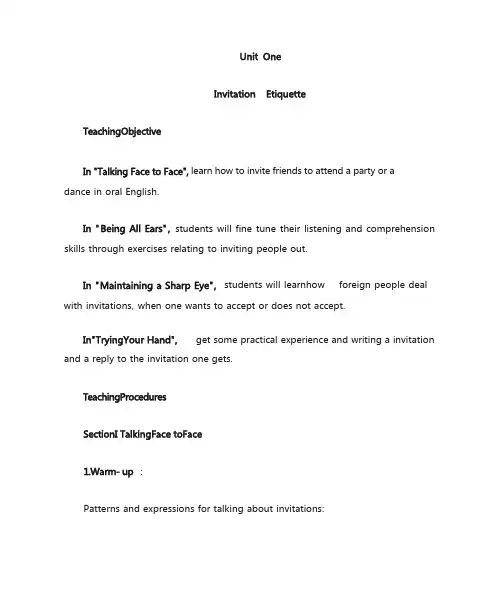
dance in oral English.students will fine tune their listening and comprehensionskills through exercises relating to inviting people out.with invitations, when one wants to accept or does not accept.and a reply to the invitation one gets.Patterns and expressions for talking about invitations:I’dliketoinviteyoutodinner.我想请你吃晚饭。
Why don’t you come and join us for disco?你为什么不和我们一起跳迪斯科?It’s very kind of you to invite me.谢谢你邀请我。
How nice of you! Many thanks.你真好!多谢。
I’dlove to. That wouldbe grea t.我很愿意去。
太好了!Oh, dear, I’m afraid I’m busy tonight. Perhaps tomorrow evening?哦,亲爱的,今晚我很忙。
明晚也许可以吧?Could you make it another time, perhaps next Sunday?你能改个时间吗,下个星期天怎样?It’s very kind of you, but you see I’ll have to prepare for my exam.非常感谢,可你知道我得准备考试。
I’m sorry I can’t, but thank you all the same.真抱歉,我不能去。
可还是要谢谢你。
Wouldyoulike to … ?您愿意…吗?I’dlike toinvite youto …我想邀请你参加…?I would like to know if you could come to …?我想知道你是否能来…May I invite you to …?敬请光临…Wouldit be possible tojoinus for… ?请问你是否能光临…?Would it be convenient to take part in …?请问你是否方便参加…?I was wondering if you would be interested in …?不知你是否有兴趣参加…?Thank you. I’ll be happy to come.谢谢.我很高兴接受你的邀请.I’dlove to. That wouldbe grea t.我很愿意去.太好了.Thank you for invitation.谢谢你的邀请.I’dbe gladtocom e.我很高兴前往.I’d love to, but I can’t come.我很想参加,但是不能来.Thank you for your invitation, but I don’t think I can make it.感谢你的邀请,但我恐怕不能赴约.Unfortunately,I’malready busy that day.很遗憾,我那天事情太多了.It’s very kind of you, but you see I’ll have to prepare for my exam.非常感谢,可你知道我得准备考试。
上英语口语课的收获和感受英语作文英文回答:Taking an English oral class has been a truly rewarding experience for me. I have learned so much and I feel likemy confidence in speaking English has really improved. Inthe class, we do a lot of speaking exercises and role-plays, which have helped me to practice using English in real-life situations. For example, we often have to pretend we are in a restaurant ordering food or in a shop asking for help. These activities have been really helpful in improving my fluency and pronunciation.Another thing I have gained from the class is a better understanding of English idioms and expressions. My teacher often explains the meanings of different idioms and encourages us to use them in our conversations. For instance, I have learned expressions like "barking up the wrong tree" and "hit the nail on the head", which I now use in my everyday conversations.Overall, I feel like my English speaking skills have improved a lot since starting this class. I am moreconfident in expressing myself in English and I havelearned a lot of new vocabulary and expressions. I amreally grateful for the opportunity to take this class andI look forward to continuing to improve my English skillsin the future.中文回答:参加英语口语课对我来说是一次非常有意义的经历。
英语口头作文常用语Useful Oral English Expressions。
Oral English is an important part of English learning. Here are some useful oral English expressions for you to use in your daily conversations.1. Greetings:Hello, how are you?Hi, how's it going?Good morning/afternoon/evening.2. Introducing yourself:Hi, I'm [your name].Nice to meet you, I'm [your name].Let me introduce myself, I'm [your name].3. Asking for information:Excuse me, do you know where the nearest bank is?Could you tell me how to get to the train station?I'm looking for a good restaurant, can you recommend one?4. Making requests:Can you please pass me the salt?Could you help me with my homework?Would you mind opening the window?5. Giving compliments:You look great today!Your presentation was amazing!I really like your new haircut.6. Expressing gratitude:Thank you so much for your help.I really appreciate what you've done for me. Thanks a million!7. Apologizing:I'm sorry for being late.I apologize for the mistake I made.Please forgive me for my behavior.8. Agreeing and disagreeing:I totally agree with you.I see your point, but I think differently. I'm afraid I can't agree with you on that.9. Asking for opinions:What do you think about this idea?Do you have any thoughts on the matter?How do you feel about the new policy?10. Ending a conversation:It was nice talking to you, see you later.I have to go now, let's catch up soon.I'll talk to you later, take care.These are just a few examples of useful oral English expressions that you can use in your daily conversations. Remember to practice them regularly to improve your spoken English skills. Good luck!。
日常生活英语口语大全Daily Life English Oral Expressions。
In our daily lives, we often find ourselves in situations where we need to communicate in English. Whether it's at work, at school, or just in our everyday interactions, having a good grasp of English oral expressions can be incredibly useful. Here are some common English oral expressions that you can use in various situations.1. Greetings and Introductions。
When meeting someone for the first time, it's important to know how to greet them and introduce yourself. Common greetings include "Hello, how are you?" or "Hi, nice to meet you." When introducing yourself, you can say "My name is [your name]" or "I'm [your name]."2. Asking for Information。
In everyday conversations, we often need to ask for information. You can use expressions like "Can you tell me...?" or "Do you know...?" For example, if you're lost and need directions, you can ask "Can you tell me how to get to the nearest bus stop?"3. Making Requests。
全国技工院校英语第二册第三版习题册答案(30道题)1. 题目:I _ (go) to the park yesterday. What about you?答案:went解析:这题考查一般过去时。
句中有yesterday这个表示过去的时间状语,动词go的过去式是went。
2. 题目:She _ (like) reading books.答案:likes解析:这题考查一般现在时的第三人称单数形式。
主语she是第三人称单数,一般现在时中,动词like要加s。
3. 题目:How many _ (book) are there on the desk?答案:books解析:这题考查可数名词的复数形式。
how many后面要接可数名词复数,book的复数是books。
4. 题目:He is _ (tall) than his brother.答案:taller解析:这题考查形容词的比较级。
句中有than,表示比较,tall的比较级是taller。
5. 题目:What's the _ (big) city in your country?答案:biggest解析:这题考查形容词的最高级。
句中有the,in your country表示范围,big 的最高级是biggest。
6. 题目:Can you _ (speak) English?答案:speak解析:这题考查情态动词的用法。
情态动词can后面接动词原形,所以是speak。
7. 题目:I'm _ (look) for my keys. Have you seen them?答案:looking解析:这题考查现在进行时。
句中的I'm是I am的缩写,am后面接动词的现在分词形式,look的现在分词是looking。
8. 题目:There _ (be) some milk in the glass.答案:is解析:这题考查there be句型。